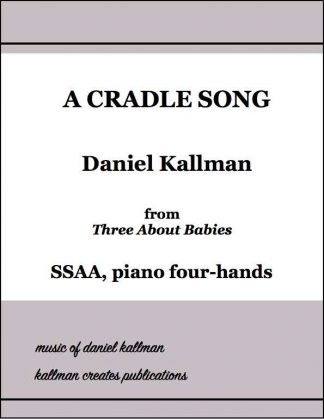Description
![]() Kallman Creates Publications
Kallman Creates Publications
An upbeat song of gratitude, for SSA chorus and piano.
Duration: 3’45”
Listen to “Gratus Animus”
(2017-2018 MMEA All-State SSAA Choir Bret Amundson, conductor.)
View “Gratus Animus”
Composer’s Notes, 2017
For some time I have wanted to compose a choral Alleluia, so when I received the invitation last year to write for the Minnesota All-State Women’s Choir, I originally thought I might to go that route. However, since a secular text was requested, I searched for a word or phrase with a similar sentiment which could serve as the primary text for the work. I chose the Latin “gratus animus” which is usually translated “gratitude”, but implies “gratitude for life”. The other reason I was drawn to these two words is that, in speaking them, the rhythm easily falls into a mixed meter of twos and threes. I am fond of using alternating duple and triple groupings in my instrumental music, but I haven’t explored it much in my choral work. So this commission presented an opportunity to create an uptempo piece with minimal text and more options to mix the meters.
When I met with the singers in rehearsal, I told them of a pinnacle musical experience of mine as a young trombonist about to enter my high school concert band. It was tradition for the incoming students to sit in on a rehearsal in late May of our freshman year with the outgoing band. One of the works they had played that year was the Profanation movement from Leonard Bernstein’s Jeremiah Symphony in a wonderful transcription that Dr. Frank Bencriscutto had done for the University of Minnesota Concert Band. Every measure was a different grouping of eighth notes alternating randomly between duple and triple formations. I had already been mesmerized by the unique rhythmic pulse of the work when I heard it for the first time from the audience earlier that year – still one of the most vivid musical memories of my life! So reading the trombone part and seeing how it was notated was really an eye and ear opener for my 14-year-old brain. We played the movement again the following year, so I became very familiar with it (still one of my favorite works of Bernstein), and I think that is the main reason I am fond of using mixed meters.
With Gratus Animus, the rhythmic energy of much of the work exists due to the alternation of twos and threes, as the words of the title are sung repeatedly during the faster sections. As bookends for the structure of the composition, I also added sparse additional text, simple exclamations of just a few of the gifts we are granted as humans and for which we should be grateful: the capacity to love and to feel, the ability to dream, the joy of singing, the potential to heal after hurting, the gift of life itself.
Composers in Minnesota are certainly blessed as each year one of us has the opportunity to write for an All-State vocal ensemble, interacting with the musicians in rehearsal. This experience allows us all to grow musically as we enjoy the collaborative joy of bringing something to life for the first time. I was deeply impressed by the entire concert offered by all three choirs in August, and I am particularly grateful to conductor Bret Amundson, pianist Christine Starr, the teachers and section coaches, and the wonderful young women of the choir for performing Gratus Animus so precisely, joyfully and gratefully!




